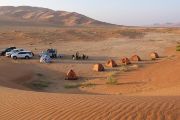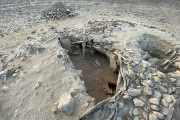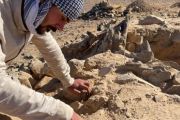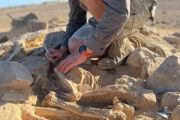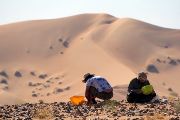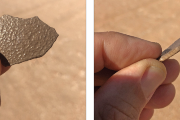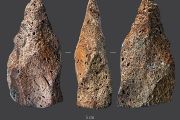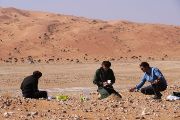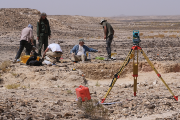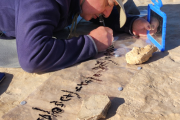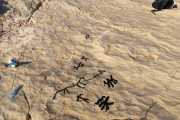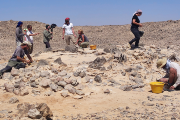
Archaeologists unearth unique finds in Oman
11. 04. 2023
Handaxes from the period of the first human migration out of Africa, eggshells of extinct ostriches, and a unique collection of rock engravings. An international team led by the Institute of Archaeology of the CAS in Prague has successfully completed its third excavation season in Oman. Thanks to the unique findings, the researchers will be contributing, among other things, to the reconstruction of the climate and history of the world’s largest sand desert.
A total of 21 archaeologists and geologists from 10 countries took part in the excavations in two areas of the Sultanate of Oman. The first expedition team was situated in the Dhofar Governorate in the south of the country. Research was carried out in the dunes of the Rub’ al Khali desert at newly discovered sites abundant in stone tools. The researchers were able to find, for instance, stone handaxes that date back to the period of the first human migration out of Africa some 300,000 to 1.3 million years ago.
“Our research on stone tools from the earlier Stone Age period in southern Oman will make it possible to chart the gradual spread of prehistoric settlements from Africa to Eurasia, when Arabia served as a natural migration corridor,” said Jeffrey Rose, head of fieldwork in Dhofar, from the Ronin Institute in the USA.
The expedition also dated a cluster of sedimentary layers with stone tools of the so-called “Nubian culture” to between 100–70 thousand years ago. The team was greatly assisted by Anthony Marks from the USA, who described the culture in Sudan. The temporal data will provide archaeologists with valuable information regarding the dispersal of anatomically modern humans (Homo sapiens) out of Africa. The team also included two stone tool experts from the Institute of Archaeology of the CAS in Brno, Czech Republic.
During the expedition, they managed to discover, among dunes up to 300 metres high, the eggshells of extinct ostriches, a fossil dune, and an old riverbed from a period when the climate in Arabia was significantly wetter.
“Our findings, supported by four different dating methods, will provide valuable data for reconstructing the climate and history of the world’s largest sand desert. Natural conditions also shaped prehistoric settlements, and what we are trying to do is study human adaptability to climate change,” said expedition leader Roman Garba from the Institute of Archaeology of the CAS in Prague.
The archaeologists made use of special dating methods. “We are carrying out radiocarbon dating and cosmogenic radionuclide dating in cooperation with the Nuclear Physics Institute of the CAS, which has newly commissioned the first accelerator mass spectrometer (AMS) in the Czech Republic. The AMS enables cutting-edge research in these dating methods,” the researcher explained.
Archaeologists in the region have also been investigating 2,000-year-old ritual stone monuments – known as triliths – located in southern Arabia. Using radiocarbon dating and spatio-temporal analysis, the team is identifying possible migrations of the ancient communities that made use of the monuments.
The second expedition
The second expedition team operated in the Duqm province of central Oman. At the Nafūn site, the team continued excavation work on a Neolithic tomb dating back to 5,000–4,600 BCE.
“What we find here is unique in the context of the whole of southern Arabia. A megalithic structure concealing two circular burial chambers revealed the skeletal remains of at least several dozen individuals. Isotopic analyses of bones, teeth, and shells will help us learn more about the diet, natural environment, and migrations of the buried population,” explained Alžběta Danielisová, co-leader of the expedition from the Institute of Archaeology of the CAS in Prague.
Not far from the tomb, the Italian-French team documented a unique collection of rock engravings spread over a total of 49 rock blocs, whose different styles and varying degrees of weathering provide a pictorial record of settlements from 5,000 BCE to 1,000 CE. Researchers also investigated stone tool production sites from the Late Stone Age.
Award-winning project
The research in Oman is part of a broader anthropological project by Viktor Černý from the Institute of Archaeology of the CAS in Prague. It examines the biocultural interactions of populations and their adaptation to climate change. “The detected interactions of African and Arab archaeological cultures characterise the mobility of populations of anatomically modern humans. It will be interesting to confront these findings also with the genetic diversity of the two regions and create a more comprehensive view of the formation of contemporary society in Southern Arabia,” Černý added.
The project was awarded the Academic Prize of the CAS in 2022. The Omani expedition can be followed on Twitter (@Arduq_Arabia), and the first part of a documentary series on the ongoing research in central Oman can now be viewed on the YouTube channel of the Czech Academy of Sciences under the title ‘Zvěd’ (@zvedzved).
The ARDUQ (Archaeological landscape and environmental dynamics of Duqm and Nejd) expedition took place under the auspices of the Omani Ministry of Heritage and Tourism. Researchers from the USA, Czechia, UK, Ukraine, Iran, Italy, Slovakia, Austria, France, and Oman took part in the project.
Download more photos from the Neolithic tomb excavation in Nafun.
Contacts:
Roman Garba
Inst. of Archaeology of the CAS Prague
garba@arup.cas.cz
Alžběta Danielsová
Inst. of Archaeology of the CAS Prague
danielisova@arup.cas.cz
Download the press release with photos' descriptions here.
Read also
- We need a new European institute for AI in science, academies advise
- Czech Republic has a new weapon against dangerous viruses and infections
- Searching for mammals in the mountains of Papua New Guinea
- Opening the door to the development of molecular chips
- The first humans came to Europe 1.4 million years ago
- Frozen behaviors in amber fossils
- Front-flip: parasitic fish embryos must learn it when they are two days old
- Light-triggered chemistry in a single molecule
- Unique butterfly-shaped magnetic graphene nanoparticle combines two concepts of magnetism formation
- Altermagnetism has been experimentally confirmed
Contacts for Media
Markéta Růžičková
Public Relations Manager
+420 777 970 812
Eliška Zvolánková
+420 739 535 007
Martina Spěváčková
+420 733 697 112
